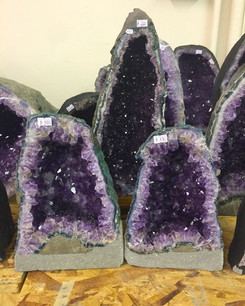Unearthing Nature’s Masterpieces: The Formation of Amethyst Geodes
- Elise Thompson
- Feb 19
- 2 min read

For the past 20 years, I’ve encountered some of the most breathtaking amethyst geodes, many of which I’ve documented at the Tucson Gem and Mineral Show and at Museums. From delicate heart-shaped stones with glistening quartz centers to immense cavernous formations towering 3 times my height, these natural wonders never fail to amaze. Their beauty is only rivaled by the fascinating story of their formation—a journey that spans millions of years deep within the Earth.

How Amethyst Geodes Are Formed
The creation of an amethyst geode is a slow and intricate process, blending volcanic activity, hydrothermal movement, and time itself. It all begins with volcanic eruptions that leave behind cavities or voids in igneous rock, typically basalt. These hollow spaces are often the result of gas bubbles trapped within cooling lava.

Over millions of years, mineral-rich groundwater seeps into these voids, carrying silica and other essential compounds. Given the right conditions—specific temperatures, pressures, and chemical compositions—silica gradually crystallizes into quartz. When trace amounts of iron are present, combined with natural irradiation, the quartz transforms into amethyst, producing its signature violet hue. The richness of this coloration varies from pale lilac to deep purple, depending on the concentration of iron and exposure to radiation.
Main Structural Features

Crystal Formation: Amethyst crystals develop inward from the walls of the cavity, creating a dense arrangement of terminated crystals. Their size and structure depend on factors such as the availability of mineral-rich fluids, the cavity's dimensions, and the speed at which the crystals grow.
Color Patterns: Many amethyst geodes display bands of varying shades, with the deepest purples often concentrated near the base of the crystals. These variations can provide valuable clues about changes in environmental conditions during their formation.
Size Range: Geodes come in a vast range of sizes, from small palm-sized specimens to massive formations measuring several meters across. Some of the largest can weigh multiple tons and showcase thousands of perfectly formed crystals.
Amethyst geodes are found worldwide, with notable deposits in Brazil, Uruguay, Mexico, Namibia, and parts of the United States.

A Hidden Beauty Within
At first glance, an amethyst geode may seem unremarkable, its exterior often appearing rugged, coated in layers of weathered rock or calcite. However, breaking one open reveals a mesmerizing inner world lined with vibrant amethyst crystals. The interplay of light on these crystalline formations creates a dazzling display of nature’s artistry—each geode a unique masterpiece shaped by geological forces over millennia.
Discovering These Geological Treasures
The awe-inspiring amethyst geodes I’ve encountered range from small, palm-sized specimens to massive formations large enough to stand inside. The Tucson Gem and Mineral Show has introduced me to some of the most extraordinary examples, offering a glimpse into the vast diversity of these formations. Each geode carries a story, a timeline of the Earth’s transformative power, and a testament to the wonders hidden beneath our feet.
Here is a showcase of my favorite amethyst geodes—12 remarkable specimens I’ve documented over the years. Whether heart-shaped or towering like a cathedral, these crystalline wonders continue to capture my imagination, and I hope they inspire you as well!

.png)



























Comments